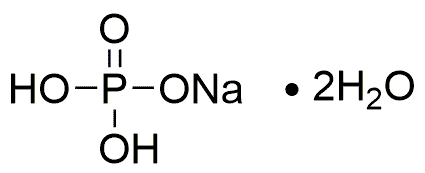Sodium phosphate monobasic dihydrate is widely utilized in research focused on:
- Buffer Solutions: It is commonly used to create buffer solutions in biological and chemical research, helping to maintain a stable pH in experiments.
- Food Industry: This compound serves as a food additive, acting as a leavening agent and acidity regulator, enhancing the texture and shelf-life of various products.
- Pharmaceuticals: In the pharmaceutical sector, it is used in formulations for drug delivery systems, improving solubility and stability of active ingredients.
- Water Treatment: It plays a role in water treatment processes, helping to prevent corrosion and scale formation in industrial systems.
- Fertilizers: The compound is also utilized in agriculture as a source of phosphorus, promoting plant growth and improving crop yields.
General Information
Properties
Safety and Regulations
Applications
Sodium phosphate monobasic dihydrate is widely utilized in research focused on:
- Buffer Solutions: It is commonly used to create buffer solutions in biological and chemical research, helping to maintain a stable pH in experiments.
- Food Industry: This compound serves as a food additive, acting as a leavening agent and acidity regulator, enhancing the texture and shelf-life of various products.
- Pharmaceuticals: In the pharmaceutical sector, it is used in formulations for drug delivery systems, improving solubility and stability of active ingredients.
- Water Treatment: It plays a role in water treatment processes, helping to prevent corrosion and scale formation in industrial systems.
- Fertilizers: The compound is also utilized in agriculture as a source of phosphorus, promoting plant growth and improving crop yields.
Documents
Safety Data Sheets (SDS)
The SDS provides comprehensive safety information on handling, storage, and disposal of the product.
Product Specification (PS)
The PS provides a comprehensive breakdown of the product’s properties, including chemical composition, physical state, purity, and storage requirements. It also details acceptable quality ranges and the product's intended applications.
Certificates of Analysis (COA)
Search for Certificates of Analysis (COA) by entering the products Lot Number. Lot and Batch Numbers can be found on a product’s label following the words ‘Lot’ or ‘Batch’.
Numéro de catalogue
Numéro de lot/série
Certificates Of Origin (COO)
This COO confirms the country where the product was manufactured, and also details the materials and components used in it and whether it is derived from natural, synthetic, or other specific sources. This certificate may be required for customs, trade, and regulatory compliance.
Numéro de catalogue
Numéro de lot/série
Safety Data Sheets (SDS)
The SDS provides comprehensive safety information on handling, storage, and disposal of the product.
DownloadProduct Specification (PS)
The PS provides a comprehensive breakdown of the product’s properties, including chemical composition, physical state, purity, and storage requirements. It also details acceptable quality ranges and the product's intended applications.
DownloadCertificates of Analysis (COA)
Search for Certificates of Analysis (COA) by entering the products Lot Number. Lot and Batch Numbers can be found on a product’s label following the words ‘Lot’ or ‘Batch’.
Numéro de catalogue
Numéro de lot/série
Certificates Of Origin (COO)
This COO confirms the country where the product was manufactured, and also details the materials and components used in it and whether it is derived from natural, synthetic, or other specific sources. This certificate may be required for customs, trade, and regulatory compliance.

